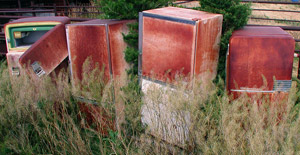The Profit-Making Allure of Product Reconstruction
Whether it involves recycling, refurbishing or remanufacturing, product reconstruction can offer attractive consumer prices, high-quality goods and a host of profit opportunities.

Image courtesy of Flickr user edcrowle.
In the face of a global recession and a recovery that could take years, minimizing the costs of raw materials and supplies is becoming a higher priority among manufacturing-company executives. “Product reconstruction” in particular—the recovery of used goods, their processing and their resale—looms as an excellent way for a company, perhaps your own, to enhance revenue, profits and market share.
Reconstruction, which covers a continuum of activities from recycling to refurbishing to remanufacturing,1 allows companies to sell goods at lower prices than if they were to assemble nearly identical new products. In most cases, the prices of remanufactured products are 50 to 75% lower than those of new ones.2 Despite lower prices, however, reconstruction provides customers with high-performance goods.
The leading question
Does your company have what it takes to succeed at product reconstruction?
Findings
- Product reconstruction—recycling, refurbishing or remanufacturing—allows for higher profit margins (typically, 20%) than the creation of new equipment (3 to 8%).
- The appropriateness of product reconstruction for a company depends on the nature of its customers—six kinds in particular make for the best fit—and its specific core competencies.
- Federal and state governments are encouraging the product-reconstruction trend through legislation and public/private programs.
Product reconstruction also allows for higher profits than the manufacture of new equipment. The average profit margin for product-reconstruction activities is 20%,3 whereas margins in the manufacturing industry typically range from 3 to 8%. By beginning the reconstruction process with components that retain much of their original value, a company eliminates many of the costs that would be incurred if the manufacturing process were to start from scratch.
Additionally, product reconstruction within a larger corporation can provide a new revenue source, allowing the company to profit multiple times from its initial investment. It can use product reconstruction to leverage its knowledge base and manufacturing facilities.
References
1.J.A. Pearce II, “In With the Old: Reconstructed Products Offer a Promising Market for Many Companies,” Wall Street Journal, Monday, Oct. 20, 2008.
2.National Center for Remanufacturing and Resource Recovery, “Remanufacturing Industry Timeline,” Rochester Institute of Technology, 2006, www.reman.rit.edu/timeline.aspx.
3.V.D. Guide, Jr., “Production Planning and Control for Remanufacturing: Industry Practice and Research Needs,” Journal of Operations Management 18, no. 4 (2000): 467-483.
4.National Recycling Coalition Inc., “U.S. Recycling Economic Information Study,” July 2001, ES2.
5.“Springfield Remanufacturing, Behlen and SC Johnson Deliver Outstanding ‘Return on Individuals,’” Manufacturing Business Technology, April 1, 2006, www.mbtmag.com/article/CA6320636.html.
6.“Remanufacturing Industry Timeline.”
7.Pearce, “In With the Old.”
8.“Remanufacturing Industry Timeline.”
9.M. Biederman, “A Used Printer? No, It’s a Refurb,” New York Times, Thursday, June 30, 2005, sec. C, p. 7.
10.R. Giuntini and K. Gaudette, “Remanufacturing: The Next Great Opportunity for Boosting U.S. Productivity,” Business Horizons 46, no.6 (November-December 2003): 41-48.
11.K. Prema, “Recycling Picks Up Savings,” Purchasing (November 17, 2005): 37.
12.M.M. Garza, “Office Furniture Stays Green With Good Intentions,” Chicago Tribune, Wednesday, June 20, 2001, 1; R. Yunich, “Office Furniture Firms Join Forces,” The Business Journal-Central New York, Thursday, Feb. 13, 2003, p. 1.
13.Ibid.
14.“Dow Jones Sustainability World Index for 2007/2008,” www.sustainability-indexes.com.
i.Electronic Product Stewardship Canada, “EPSC Tour of Electronic Waste Producer Responsibility Programs” (July 7, 2003), www.epsc.ca/pdfs/europe.pdf.
ii.“Directive 2002/96/EC of the European Parliament and of the Council” (February 13, 2003), europa.eu.int/eurlex/pri/en/oj/dat/2003/l_037/l_03720030213en00240038.pdf.
iii.“Remanufacturing Industry Timeline,” www.reman.rit.edu/timeline.aspx.
iv.Ibid.
v.E.G. Stack, “SJM 9 -- A Joint Memorial Requesting the Secretary of Environment to Appoint a Task Force,” EIA Survey of CRT Glass Manufacturing Industry (2005).

Comments (4)
Laser Blue
Siswanto Gatot
Guy Siverson
drsbanerji